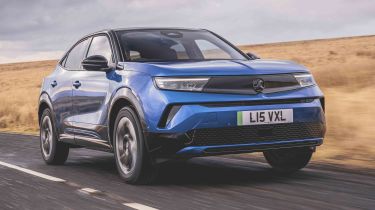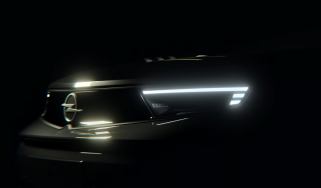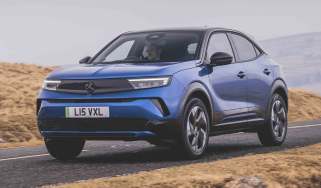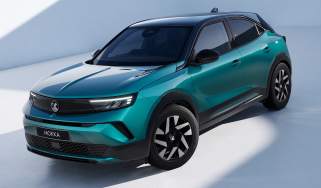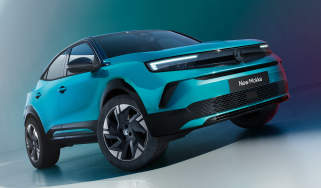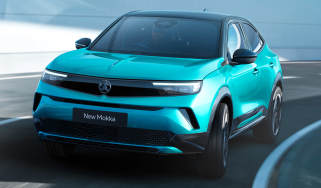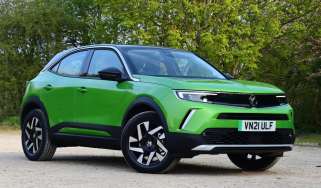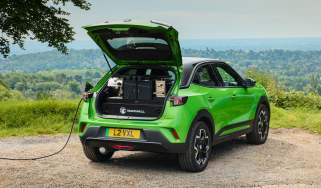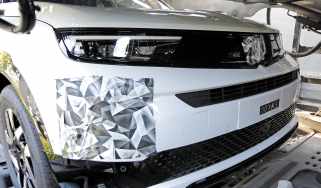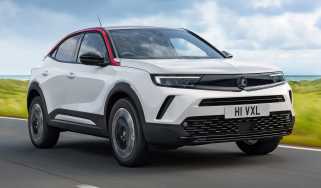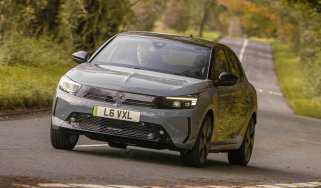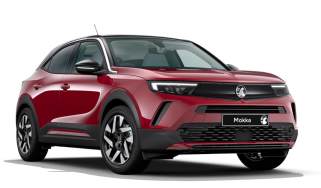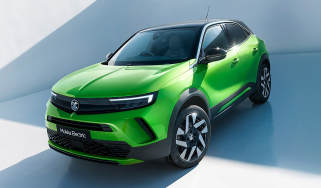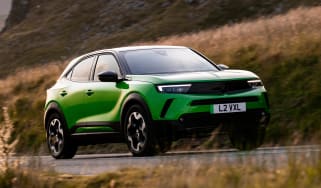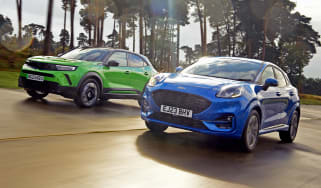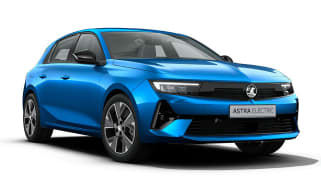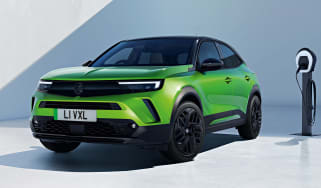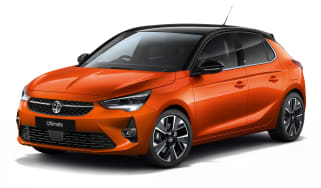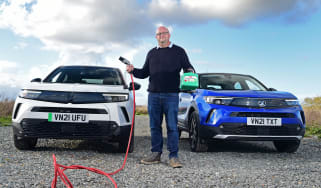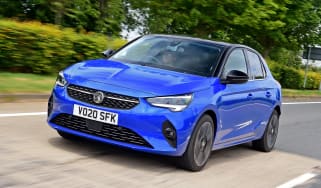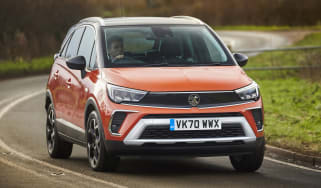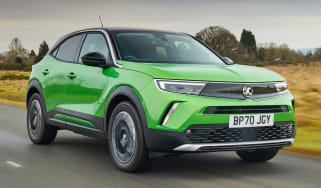Vauxhall Mokka review
The Vauxhall Mokka looks sharp and has an engine to suit most needs. However, rivals are better to drive
Is the Vauxhall Mokka a good car?
It takes some doing to stand out in the current small SUV class, but the Vauxhall Mokka does a fine job against its rivals. Its sharp and distinctive lines offer plenty of kerb appeal, while the up-to-date interior and helpful on-board tech show that there is some substance behind the looks.
An update in 2025 provided nothing particularly innovative, interesting or out of the ordinary in isolation, but myriad small changes add up to make the updated Vauxhall Mokka a better car than it was before. It’s simple to drive, reasonably efficient and practical enough for small families, but this top-spec electric version is hard to justify alongside the cheaper trims and petrol powertrains – not to mention the swelling crop of affordable EVs coming to market.
| Key specs | |
| Fuel type | Petrol, hybrid, electric |
| Body style | Small SUV |
| Powertrain | 1.2-litre, 3cyl turbo petrol, front-wheel drive 1.2-litre, 3cyl turbo petrol MHEV, front-wheel drive 54kWh battery, 1x e-motor, front-wheel drive |
| Safety | 4-star Euro NCAP (2021) |
| Warranty | 3yrs/60,000 miles |
How much does the Vauxhall Mokka cost?
The Vauxhall Mokka may not be a household name in the same way as its Vauxhall Astra and Vauxhall Corsa siblings are, but it’s still an immensely important model for the brand. It’s a regular fixture in the UK’s top 10 best-selling cars, with its wide choice of powertrains giving it an edge in a hotly contested part of the market.
Yet barely a week goes by without a new B-segment SUV joining the ranks – either from Europe or, more likely these days, China. To keep things competitive, Vauxhall has treated its popular Mokka to a subtle nip and tuck, plus a set of mid-life tech changes.
The styling is broadly unchanged, with the external tweaks limited to a reprofiled bumper and a three-block lighting signature front and rear. The EV gets an updated alloy wheel design, and there are a few new paint options, including the gloss metallic Colibri Blue (a £700 option) of our test car. But the second-generation Mokka was always a smart-looking thing, so it makes sense not to have messed with the aesthetic all that much.
Inside, all versions get a 10-inch central screen with wireless Apple CarPlay and Android Auto. It’s a robust system, and held our connection faultlessly during our time with the car, even if the screen itself isn’t the most responsive or easy to navigate. The main display sits next to a fully digital instrument cluster and within Vauxhall’s ‘Vizor’ panel; both are bright and easy to read.
Elsewhere, there’s a new steering wheel that’s slightly flatter and squarer than before, with redesigned buttons that are intuitive enough to use on the move. The centre stack still features easy-to-operate rotary climate controls, although there are now fewer physical buttons directly below the main screen. We didn’t find this too much of an issue, however.
An advantage of being part of the Stellantis automotive family is having access to tried-and-tested engines. Petrol models make use of the conglomerate’s PureTech 1.2-litre, three-cylinder engine with either 128bhp or 134bhp (depending on whether you opt for the manual or automatic), while a ‘Hybrid’ version is available, too. The Mokka Electric (formerly the Mokka-e) employs the parent group’s all-electric powertrain as seen in the Peugeot E-2008 and Citroen e-C4. Since the range was facelifted in 2025, all Mokka EVs get an updated 54kWh (51kWh useable) battery for up to 249 miles of range.
Each powertrain is available across three trim levels: Design, GS, and Ultimate. Standard kit on all models includes Vauxhall's Pure Panel infotainment set-up that incorporates a digital instrument display, a central touchscreen with wireless Apple CarPlay and Android Auto connectivity, LED headlights, alloy wheels, cruise control, lane-departure warning and a driver drowsiness alert system.
Prices start from just over £25,000, but as you press on through the range, things become noticeably more expensive, with the top-of-the-range hybrid costing more than £31,000, and a Mokka Electric Ultimate breaching £38k.
Engines, performance & drive
The previous-generation Mokka X was not a good car to drive, and while the second-generation Mokka still doesn’t offer as much driver involvement as the Ford Puma, it’s a more refined car than before.
There is still a choice of petrol and hybrid variants – each with around 130bhp. Our experience with the pre-facelift petrol car suggests the base engine will be perfectly adequate for most urban journeys, with the eight-speed automatic transmission, in particular, impressing us at lower speeds. It's easily a match for the dual-clutch automatic set-up of its Volkswagen Group rivals such as the Skoda Kamiq and SEAT Arona.
We’ve not driven either engine in the recently revised Mokka (only the EV), but we’ve tried them in a handful of the Vauxhall’s Stellantis siblings. The base version should feel sprightly enough, while the hybrid is moderately more efficient, claiming up to 57.8mpg on the combined cycle.
On the road, the latest Mokka doesn’t feel dramatically different. It’s still relatively grown up, and holds its own on most surfaces and road types. Run the car in its Normal mode and you’ll find it has enough power for ‘normal’ driving. Eco pegs things back and makes the Mokka feel quite lethargic, while Sport can feel a bit jerky in its responses.
The Mokka Electric is much quieter than the petrol versions, and it’s extremely smooth when accelerating off the line. It doesn’t feel as rapid as some electric cars, but it’ll keep up with traffic well enough. You’ll need to engage Sport mode to exploit all its performance potential, because power is pegged in Normal and Eco driving modes in a bid to preserve electric range.
The easily accessible ‘B’ mode on the gearlever ramps up the regenerative braking, and while it won’t bring the car to a complete stop, it’s strong enough to reduce dependence on the left pedal in town. Turn it off on faster roads, and it’ll still feed energy back into the battery when coasting, albeit with significantly less aggression.
Overall, a Ford Puma is more fun, and a Skoda Kamiq is probably more comfortable. But the Vauxhall is the kind of car you can just hop in and drive, without much in the way of drama or surprise.
| Model | Power | 0-62mph | Top speed |
| Mokka 1.2 Turbo 136PS manual | 134bhp | 8.9s | 129mph |
| Mokka 1.2 Turbo 130PS auto | 128bhp | 8.9s | 126mph |
| Mokka Hybrid 1.2 136Ps e-DCT6 | 134bhp | 8.2s | 129mph |
| Mokka Electric 54kWh 156PS | 154bhp | 9.0s | 93mph |
What is the Vauxhall Mokka like to drive?
In town
We found the Mokka rides best at low speeds around town, where its CMP chassis (shared with Peugeot and Citroen) deals with the worst elements of scarred UK tarmac quite well. The suspension set-up can struggle to remain composed at higher speeds, but overall, the balance will be fine for most drivers.
On A- and B-roads
If you start to flex your right foot and push on, you’ll notice the unmistakable growl of the three-cylinder engine. Don’t be fooled into thinking any extra noise will yield an equal increase in performance – the Mokka is not a particularly quick car. Vauxhall has tried its best to accentuate the positive by offering a Sport driving mode, but it doesn’t make any meaningful benefits to the driving experience.
The EV doesn’t feel dramatically different, but the smooth power delivery and instant torque feels punchy enough out of tight corners. The weight penalty isn’t significant enough to have much bearing on the driving experience, either.
On the motorway
The motorway is the only place where the Mokka feels a little out of its depth. None of the engines feel particularly well suited to long motorway journeys, even if refinement is acceptable. The EV’s 154bhp electric motor gets off the line just fine, but lacks that instant shove on the move at higher speeds when the traffic in front clears and you want to accelerate, say, from 50-70mph. Range will take a hit if you sit at the national speed limit for long periods.
0-62mph acceleration and top speed
The entry 99bhp 1.2-litre petrol version in the pre-facelift Mokka has now been discontinued, leaving the base engine as a more potent 128bhp 1.2-litre petrol. It slashes the 0-62mph sprint from 10.6 seconds to 8.9 seconds. The 136bhp Hybrid is slightly faster (8.2 seconds) thanks to its added electrical assistance.
The outgoing Mokka Electric (formerly the Mokka-e) had an electric motor producing 134bhp and 260Nm of torque, and managed 0-62mph in 9.2 seconds. However, the latest version produces 154bhp from its single electric motor, which should allow for a 0-62mph in nine seconds flat. Both versions of the electric Mokka have the same electronically limited top speed of 93mph.
MPG, emissions & running costs
Choose any Vauxhall Mokka with a petrol combustion engine, and you’ll benefit from great fuel economy. But if you're looking for the lowest possible running costs, then the Hybrid is the one to go for. Of course, if you drive a company car or can charge at home on an off-peak electricity tariff, the Mokka Electric is worth considering, too.
Vauxhall claims the basic 128bhp petrol Mokka with its six-speed manual gearbox will return up to 49.6mpg. There's a small efficiency penalty if you opt for the automatic gearbox (46.3mpg), and when we tested this particular version of the pre-facelift Mokka, it averaged 38.6mpg. The Hybrid is likely to be the most economical petrol-powered Mokka, capable of 57.7mpg in official tests.
The CO2 levels for the petrol cars range from 110g/km to 138g/km, with Benefit-in-Kind (BiK) tax rates for company car drivers between 27 and 32 per cent.
If you’re interested in the EV, then just be aware of how the cold weather can affect efficiency. We tested the latest Mokka Electric on a cool (five to seven degrees ambient temperature, occasionally rainy) day, returning efficiency of around 3.7-3.8mi/kWh. That translates to about 190 miles of range (versus an official rating of 249 miles), or a little less if you’re sitting at a constant 70mph on the motorway. The optional £400 heat pump is a worthwhile addition, because it provides a more efficient way of heating the car up in cold weather. Ultimately, though, it’s probably best to treat the Mokka as a capable urban runaround that’s suited to an occasional long run should the need arise.
| Model | MPG | CO2 | Insurance group |
| Mokka 1.2 Turbo 136PS manual | 49.6mpg | 129g/km | 22 |
| Mokka 1.2 Turbo 130PS auto | 46.3mpg | 138g/km | 22 |
| Mokka Hybrid 1.2 136PS e-DCT6 | 57.7mpg | 110g/km | 24 |
Electric range, battery life and charge time
The Vauxhall’s 100kW peak charging speed means that while a zero to 80 per cent top-up should take just 30 minutes, it lags behind newer models such as the Kia EV3 (150kW) and forthcoming Skoda Elroq (175kW). The Mokka’s 54kWh (51kWh usable) battery will easily charge to full on a 7kW home wallbox overnight in around 7.5 hours.
| Model | Battery size | Range | Insurance group |
| Mokka Electric 54kWh 156PS | 249 miles | 0g/km | 24 |
Tax
Every new Vauxhall Mokka – even the top-spec Electric Ultimate – comes in at less than £40,000, which means no model should be subject to the luxury VED (car tax) supplement.
Insurance
Insurance premiums for the Mokka shouldn’t break the bank, with the entry-level 1.2 Turbo 128bhp sitting in group 22. The Hybrid and Electric versions fall into group 24.
If you want something with lower insurance premiums, look at the SEAT Arona, because the 1.0-litre models start in group 10, and go up to group 18.
Depreciation
According to our latest expert data, over a typical three-year/36,000-mile ownership period, the Mokka should maintain between 44-48 per cent of its original value. That’s alright, but a little disappointing when the Volkswagen T-Cross will hold onto between 47-52 per cent over the same period.
The Mokka Electric is only predicted to be worth around 33 per cent of its original value over the same period, which is very disappointing next to the Kia EV3’s 48-51 per cent.
To get an accurate valuation for a specific model, check out our free car valuation tool...
Interior, design & technology
The second-generation Mokka ushered in a fresh approach to design for Vauxhall, because it introduced the ‘Vauxhall Vizor’ grille design. This flourish now features across the range, from the basic Vauxhall Corsa to the range-topping Vauxhall Grandland – and everything in between.
Taking cues from the Opel GT X Experimental concept, released in 2018, the Mokka employs much of that car’s front-end design, with an all-new grille, ultra-slim LED daytime running lights and more prominent badging.
While the Mokka is definitely one of the more attractive small crossovers, none of this matters if it can’t mix with the best when it comes to outright value for money. A top-spec Electric Ultimate model does look expensive on list price alone (£36,270), but the entry-level Design trim costs £31,420 with the same battery and motor, and still comes with much of the kit you’d consider necessary in this kind of car. Features such as LED lights, 17-inch alloy wheels, cruise control and those twin 10-inch screens are all included.
Of course, if you’re not looking for an EV, the otherwise appealing petrol Mokka starts at £23,480 with a manual gearbox, so unless you’re keen to slash your Benefit-in-Kind (BiK) tax bill and run one as a company car, this will likely make a lot more sense. Upgrading to GS trim costs just £1,200 and adds a sportier look thanks to its black roof and 18-inch wheels. You also get a reversing camera and tinted rear windows.
If you do want all the bells and whistles, this Ultimate spec will tick a lot of boxes, however. It comes with matrix lights, keyless entry, heated seats, a heated steering wheel, additional autonomous safety technology features and built-in navigation for the infotainment display.
Vauxhall says a like-for-like, petrol-engined Ultimate is only around £50 more per month over four years with a £2,000 customer deposit, although that gulf extends to roughly £90 per month when comparing identical EVs.
What is the Vauxhall Mokka like inside?
The Mokka’s classy exterior design is mostly matched inside. You’ll find a pair of screens that appear to flow into each other across the top of the dashboard in what Vauxhall dubs, the Pure Panel. It consists of a 10-inch digital instrument cluster with a certain degree of customisation to its layout and the information on display, alongside a 10-inch central infotainment display.
Vauxhall deserves some credit compared with the revised Ford Puma, because the Mokka retains some simple-to-use physical buttons and dials for the climate control system. This means that you won’t need to delve into the screen as you do with the Puma in order to complete straightforward tasks, such as adjusting the temperature or switching on a heated seat (if fitted).
What is the interior quality like?
The materials used are a definite step up from the previous-generation Mokka, with piano-black and carbon-fibre effect trim throughout the cabin and not so much use of the cheaper, harder plastics that you might associate with a small Vauxhall.
Sat-nav, stereo and infotainment
Vauxhall has named its onboard tech set-up ‘Pure Panel’, with the intended effect being to create the look of one continuous digital display. All cars now get a 10-inch central touchscreen and an easy-to-read digital driver's display.
During our testing, we found that the Mokka’s tech held a stable wireless connection via Apple CarPlay. The user interface is a little fiddly compared with the easy-to-use interface found in the Hyundai Kona, and it can be a bit laggy at times, too. We also noted that inputting a postcode into the sat-nav system takes more steps than is necessary.
Boot space, comfort & practicality
The Vauxhall Mokka offers a pleasant, comfortable ride, with enough positive attributes to make it a decent buy. For example, the range of petrol, hybrid and all-electric powertrains allows customers to make the best choice to suit their day-to-day needs, while standard kit, even on base Design-spec cars, includes helpful features such as a reach and rake adjustable steering wheel, cruise control and electric door mirrors.
There aren’t many particularly practical touches in the cabin; the cubby under the central armrest is pokey and the cupholders won’t hold more than a small bottle. A Skoda Kamiq has more clever touches dotted around its interior.
We found the Mokka’s A-pillars were quite wide and could be an issue for some in attempting to gain the best view of the road – particularly at junctions. The rear window is quite small, too, so we’d suggest stepping up to mid-range GS trim because that provides you with rear parking sensors and a reversing camera to make manoeuvring easier. The range-topping Ultimate adds front parking sensors.
That top-of-the-range version has fancier matrix-LED headlights that automatically adapt the beam pattern at night to avoid dazzling oncoming traffic.
| Dimensions | |
|---|---|
| Length | 4,151mm |
| Width | 1,791mm |
| Height | 1,534mm |
| Number of seats | 5 |
| Boot space | 350-1,105 litres (ICE + Hybrid) 310-1,060 litres (EV) |
Dimensions and size
The latest Mokka measures 4,151mm in length and 1,791mm across (not including mirrors). In comparison, the Ford Puma – already one of the shortest supermini-sized small SUVs, measures 4,207mm nose-to-tail and 1,805mm wide.
How practical is the Vauxhall Mokka?
Seats & space in the front
Space up front is more than adequate for two adults to travel in comfort, and there’s a decent amount of adjustment in the driving position to find a comfortable position. You’ll need to upgrade to the top-of-the-range Ultimate trim in order to get an electrically adjustable driver’s seat with lumbar controls. It also includes a massage function, which is rare for this class of car, although it certainly isn’t the best example that we’ve tried.
Seats & space in the back
Headroom is generous enough, but taller adults may struggle behind similarly sized drivers due to the inherent issues of having such a short wheelbase. There are three seats across the back, but anyone in the middle will have a small hump in the floor to contend with, limiting overall comfort, and adult passengers will not wish to spend much time tucked behind a similarly sized adult up front.
GS and Ultimate models feel particularly dark and a touch claustrophobic in the back – thanks to the standard-fit dark headliner.
Parents with youngsters who need child car seats will find that there are a pair of ISOFIX seat mounting points provided on the outer positions of the rear seats. They aren’t as easy to locate as the ones in the SEAT Arona, Skoda Kamiq, and Volkswagen T-Cross, which are accessible behind some easy-to-remove plastic trim. The limited rear legroom might also mean you have to push the front seats forward to accommodate chunkier child seats.
Boot space
The 350-litre boot (310 litres for the Mokka Electric) is pretty much par for the course, although the squarer tailgate and less raked rear screen on a Peugeot 2008 makes that car a bit more versatile overall. The EV’s moveable boot floor means there’s room to store the charging cable, even if there’s no extra space under the bonnet.
Folding the Mokka's rear seats down gives you 1,105 litres of volume to play with if you load the car to the roof, or 1,060 litres in the EV.
Towing
Maximum towing weight for the petrol Mokka is rated at 1,200kg, which is good enough to be able to haul a trailer or small caravan. The electric version isn’t rated to pull anything.
For maximum towing capacity in a small SUV, look at the four-wheel drive ‘4Motion’ Volkswagen T-Roc, because that can haul up to 1,700kg in both 2.0-litre petrol and diesel forms.
Safety & reliability
The Vauxhall Mokka has moved further up the rankings compared with its rather dismal last place result in our 2023 survey. However, that still puts it in 34th place out of 50 cars in the overall 2024 Driver Power customer satisfaction survey, and while that is above the Skoda Kamiq (40th), it falls short of the Nissan Juke (28th), SEAT Arona (26th), Ford Puma (10th), and Peugeot 2008 (eighth).
The Vauxhall brand came in 26th out of 32 manufacturers in the 2024 Driver Power rankings, with owners praising economy and running costs, but having grumbles with pretty much every other area. Particular concerns surround practicality and the interior, with limited rear legroom, a shortage of useful storage space and poor visibility from behind the wheel all having an impact on the marque’s overall score.
Euro NCAP awarded the Mokka a four out of five-star safety rating, with concerns raised about the protection of the driver's chest and legs in a frontal impact, not having a central airbag to prevent the front seat occupants from colliding with each other in a side impact, poor neck protection for children seated in the back, plus its automatic emergency braking (AEB) not recognising cyclists.
Safety kit is generous, with entry-level Design models including a lane-departure warning with a lane keep-assist function, speed sign recognition, automatic emergency braking, a forward collision alert and a driver drowsiness alert. Adaptive cruise control comes with the top-of-the-range Ultimate, as well as blind spot monitoring – all of which feature as standard on the entry-level VW T-Cross.
| Key standard safety features | Euro NCAP safety ratings |
|
|
Warranty
All Vauxhall cars have a three-year/60,000-mile warranty, which matches the coverage you get with a Ford Puma or Volkswagen T-Cross, but lags behind the seven-year warranty offered by Kia, or the 10-year package provided by Toyota – although you do have to get your car serviced annually at a Toyota dealer in order to maintain the cover over this period.
The Mokka Electric has a separate eight-year or 100,000-mile policy for the battery pack. If the battery’s usable capacity drops below 70 per cent during that time, Vauxhall will replace it for free.
Servicing
The service schedule for the Mokka is every 12,500 miles or annually, whichever comes first, and Vauxhall offers individual service plans starting from around £20 a month to help spread the cost of scheduled maintenance.
The Mokka Electric needs an initial service after one year or 8,000 miles, whichever comes soonest, then it’ll need to be serviced every two years or 16,000 miles from that point onwards.
Vauxhall Mokka alternatives
There has perhaps been a slight image problem over recent years for many Griffin-badged cars, so it’s encouraging to see Vauxhall focusing on a clear approach to its future design and attempting to raise levels of perceived quality, especially because the Mokka rivals the likes of the Ford Puma, Hyundai Kona, Renault Captur, Skoda Kamiq and Nissan Juke in the hotly contested small SUV segment.
Electric rivals are coming in thick and fast, too. The Puma will soon be offered as an EV called the Ford Puma Gen-E, while the Hyundai Kona Electric has been available with a zero-emissions powertrain since 2018. Other electric rivals include the mechanically similar Peugeot E-2008 and Citroen e-C4, as well as the Kia EV3 and Skoda Elroq.
Frequently Asked Questions
Against other small SUV rivals, it’s good that the Vauxhall Mokka offers a choice of petrol, hybrid and electric power. However, it isn’t the best to drive, and it isn’t the most practical option around.
More reviews
Car group tests
Long-term tests
Which Is Best
Cheapest
- Name1.2 Turbo 136 Griffin 5dr
- Gearbox typeManual
- RRP£25,520
Most Economical
- Name1.2 Turbo 136 Design 5dr
- Gearbox typeManual
- RRP£25,630
Fastest
- Name1.2 Turbo 136 Design 5dr
- Gearbox typeManual
- RRP£25,630

